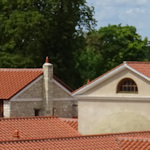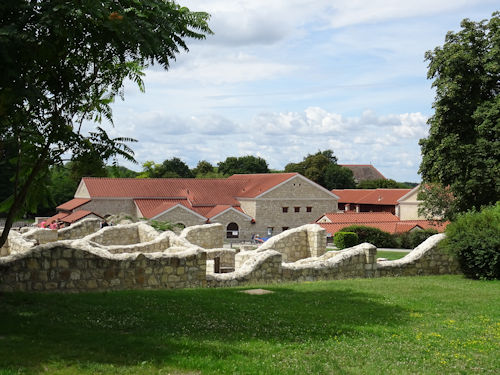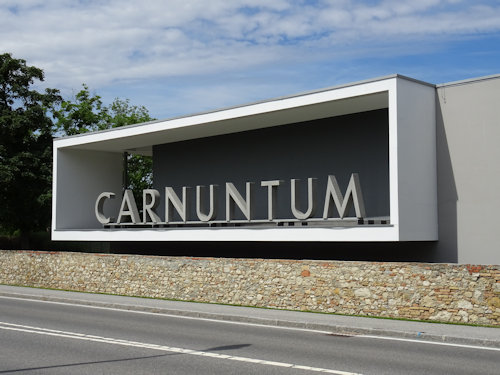
The Carnuntum Roman archaeological park covers a number of sites, but the biggest takes you into a Roman town. And I don’t mean through some virtual reality sleight of hand. We’re taking truly authentic reconstructions here…you see, smell, touch (and taste) the past.
- Go inside several full-size buildings and look around
- The reconstructed public baths are particularly impressive
- Lots of authentic little touches
- Restaurant also offers a couple of original Roman dishes
- 2024 season runs until Nov 17
- See also:
Baths, villa, and more…
The main site at Carnuntum takes you through four (sorry, IV) parts:
- The Roman reconstructions and outdoor area
- The indoor exhibition
- The restaurant
- The ticket office and shop
The Roman reconstructions

(View across to the reconstructions)
Think archaeological park and excavations and you might imagine a large number of unidentifiable stones. In a muddy field. With the occasional indecipherable inscription: the kind that have you regretting you never took Latin at school.
Carnuntum is nothing like that.
The main location is where the civilian city once stood. The outdoor display begins with a large-scale model of the entire Roman settlement and military base, giving you a feel for the remarkable size of the place.
Then you move on to the reconstructions of a handful of buildings from a small part of that city. These include the public baths, an upper class villa, a middle-class house, a small house, and an oil merchant’s premises.
Again, you might imagine a vague effort to capture the look and feel of Roman buildings using plasterboard, concrete, and some fading plastic display cases.
Nope.
First, they modelled the reconstructed buildings and surrounding cityscape on the actual size and layout of the area they stand in. In other words, the reconstructed villa, for example, has the exact same dimensions and location as the original.
Second, everything reeks of authenticity. This begins with drawing on historical records and surviving antiquities to ensure accurate designs, layouts, colours etc..
As far as possible, they used Roman building materials (some original) and only tools available to the Romans. They even cut the timber by hand. The small house has the original floor mosaic in it.
And the authenticity doesn’t stop there.
Go inside the buildings and wander around. They look as if the occupants only just left. So you find fresh fruit and vegetables lying in the kitchen, a discarded cloak on a workbench, and water coursing through the Roman baths.
The absence of barriers or display information inside ensures the experience feels remarkably genuine: imagine walking onto a movie set before the day’s filming starts. This also means, however, that you might need a guide book or the Carnuntum app to get detailed information on what you’re looking at.
(Incidentally, the display boards outside that introduce each building are in English, too. And the outdoor area also has a playground for children.)
And the rest…
(The Carnuntum welcome centre)
A small exhibition has, for example, large video installations that give you a flavour of civilian, gladiatorial, and military life in Roman Carnuntum. Most (but not all) information is also provided in English.
The restaurant (the “Forum Culinarium”) has a small, but tasty, menu that included two Roman dishes when I visited:
- Moretum viride: a Roman-style sheep cheese spread
- Lucanian pan-fried sausage (which my wife had and found a little coarser and drier than typical Viennese sausages)
The entrance area with the ticket counter has a shop, with heaps of Roman and Latin-themed souvenirs. This is where to get your legionnaire’s helmet or a Veni Vidi Vici t-shirt (all the rage in downtown Londinium).
How to get to the reconstructions
See the main article on the Carnuntum archaelogical park for extensive tips on how to travel here from Vienna.
The reconstructions appear at the main site, marked with an M on the map below:
